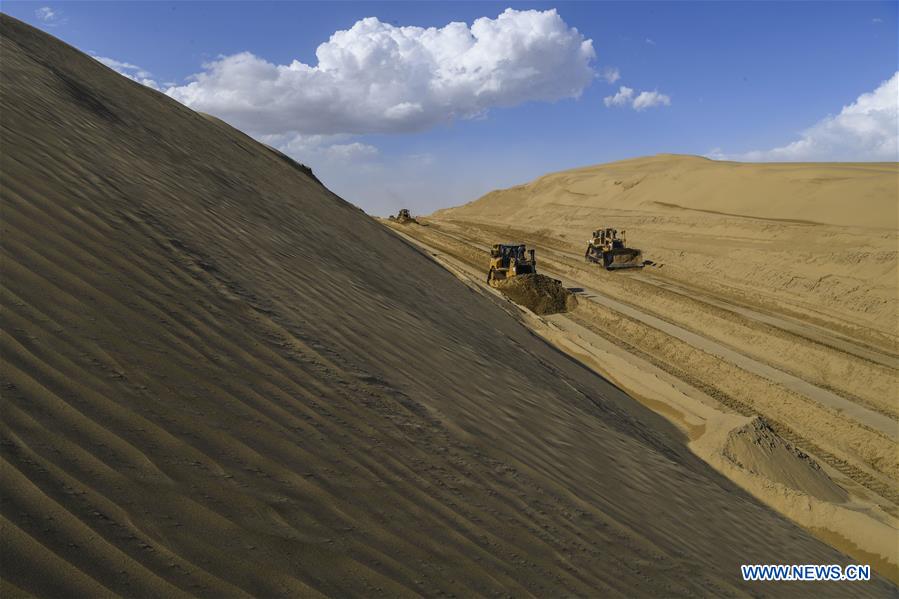Building a highway through the 'sea of death'
The third highway is being built to across he Taklamakan, which is known as the "sea of death" across China.
Five bulldozers were working on the side of a nine-meter high dune. Sand swirled into Zhang Xiaodong's driving cab, the fine dust collecting in the lines of his sweaty face. All the while, the scotching summer sun beat down on the Taklamakan, China's largest desert, in Xinjiang Uygur Autonomous Region.

Vehicles work at a desert road construction site in Taklamakan desert in northwest China's Xinjiang Uygur Autonomous Region, July 5, 2018. [Photo/Xinhua]
Zhang is here to build a road. Not just any road. This road cuts through the Taklamakan, which is known as the "sea of death" across China.
This is the third highway to be built across this desert. It will connect the counties of Qiemo, to the north, and Yuli, in the south. The word "Taklamakan" means "go in and you won't come out" in Uygur. When the road is finished, however, people from the two counties in the northwestern region will happily venture into the 337,000-square-km desert, after generations of bypassing it.
More than a half of all the desert in China is in Xinjiang. For this reason, it is hard to underplay the importance of roads through these vast expanses. The first highway across the Taklamakan, running 522 km from Lunnan, in the north, to Minfeng county, in the south, was inaugurated in 1995. At 522-km long, it is the world's longest desert highway. The second highway, 424-km long, opened to traffic in 2007, linking the resource-rich and densely-populated city of Hotan, in south Xinjiang, and Aral, an underdeveloped new city on the northern edge of the desert.
Work has now begun on the third road, which will stretch for about 330 km. It is expected to open to traffic in 2021. Hundreds of people from across the country have been recruited to construct the highway. After beginning work in Qiemo, Zhang and his team have reached the hinterland of the desert, more than 60 kilometers from their starting point.
Zhang, 47, came to work in Xinjiang 30 years ago. He cut his teeth on roads that were being built to transport the region's oil produce. Maneuvering the bulldozer to compress sand to create the road surface is second nature to Zhang. The desert road job comes with a healthy paycheck on the one hand, but on the other is extreme heat, a lack of water, poor access to electricity and bad phone signal. Not to mention the sand storms.
"I'm from Sichuan Province, a place with green hills and clean water. But I have spent most of my life in the sand," said the sturdy, swarthy man. As well as Xinjiang, Zhang also has extensive experience in Saudi Arabia and the United Arab Emirates.
This road, he said, seems to be his toughest project so far. Working for ten hours a day, he makes 100s of trips between dunes, and can dig up to 2,000 cubic meters of sand.
Li Qiushen, chief engineer of the highway project, is also seasoned in desert highway construction. He understands how difficult this one is; "The road will pass dense, high dunes in the east of the desert. There are 32 of them, and the highest one towers more than 100 meters into the sky. Between are 28 slacks, ravines between the dunes, the widest is 12 km across. The further we go, the more difficult it gets."
In response to the limited water resources, this project makes use of the area's most abundant resource -- sand, which is compressed to become roadbed. They dig out sand from the dunes to make the slopes gentler, and fill the slacks with sand. To prevent heatstroke, work stops at noon, and sheds have been provided so the workers can rest through the hottest part of the day.
It was 7:00 pm, but the temperature was still above 50 degrees Celsius. To cool down, Zhang gulped down a bottle of water. There's nothing but sand, as far as the eye can see. Eye problems are common among these workers, and yet few people quit.
"The work is hard but it pays well," Zhang said.
Zhang says workers like himself are migratory birds in the desert; "We always move from place to place for different construction projects," he said, wiping sweat from his face.
The sandy roadbed will later be paved with layers of gravel and asphalt. But before that, laying sand barriers is an essential step to prevent the road from being buried by drift sand.
This job goes to Yang Yong, 33, and his 60 co-workers. Along the road paved by Zhang, they build reed checkerboard sand barriers, which look like bars of chocolate from the sky.
There are a lot of couples in this team, which explains the good teamwork. The men can carry up to 70 kilos of reeds onto the dunes. The women then lay the reeds on the sand and the men dig the dried reeds into the sand with shovels, making squares of one square meter. Every step in the desert is two-times harder than on stable ground. Some of the women simply work in socks.
There's not much entertainment after work. Everyday, Yang's wife calls her family. "I've been here long enough to know which dune has the best cellphone signal," she said while dialing.
Zhang said once they kept some chickens in the hope of improving their dinner offerings, but strong wind swept two of the birds away.
"We have so many things to talk about when we see someone outside the desert," he said, "Sometimes we long for life in the cities, but when we finally get to the big city, we always miss the serenity of the dunes."

